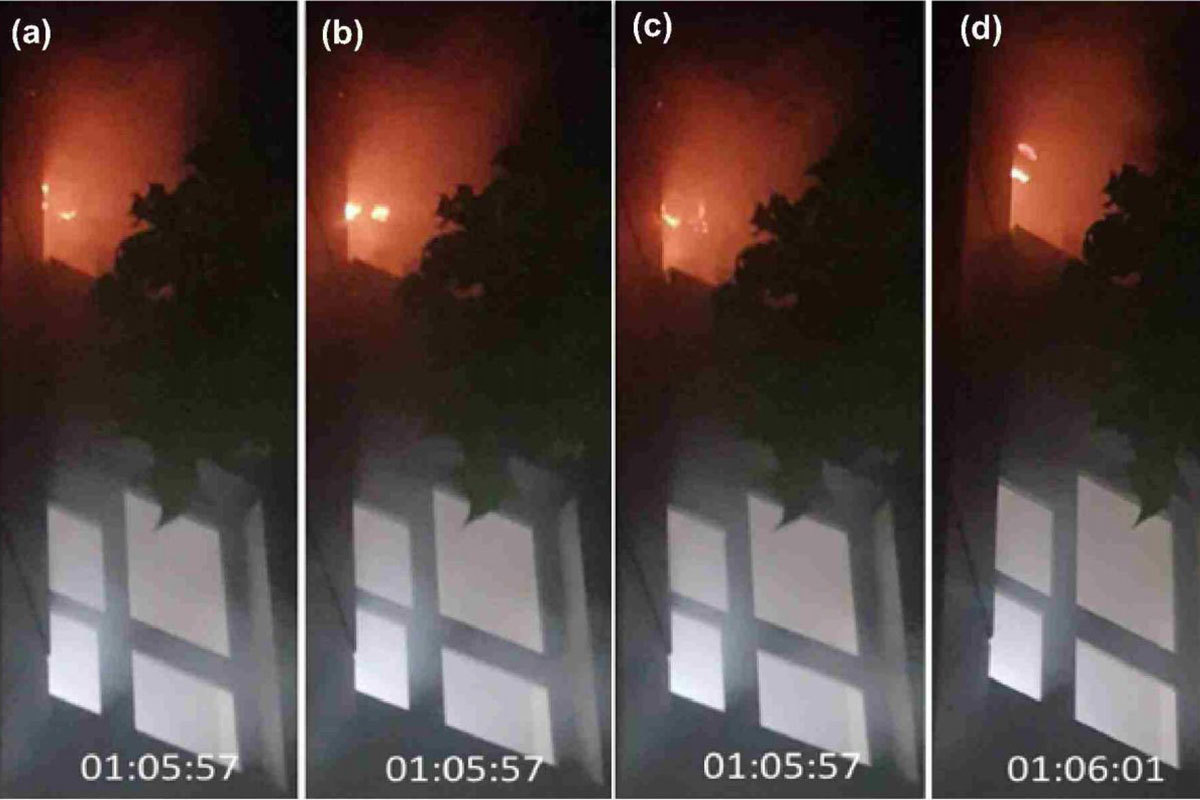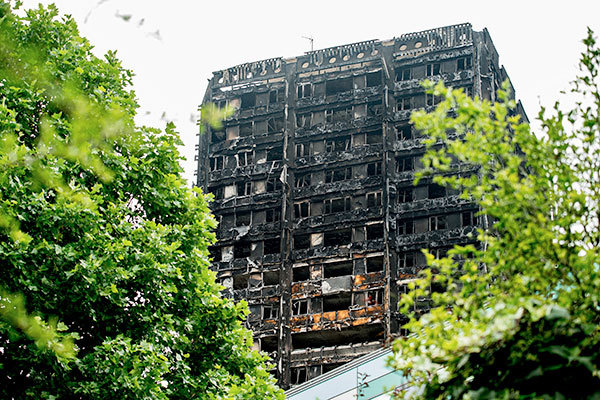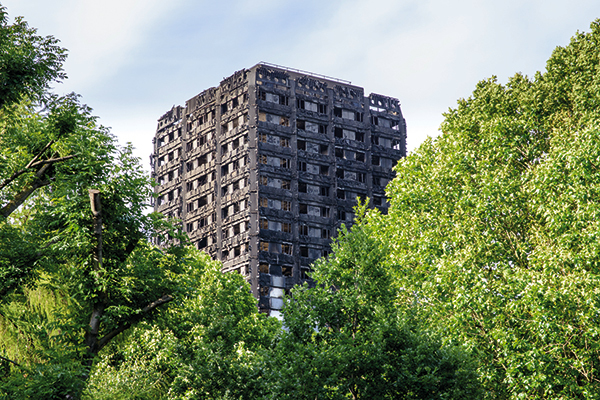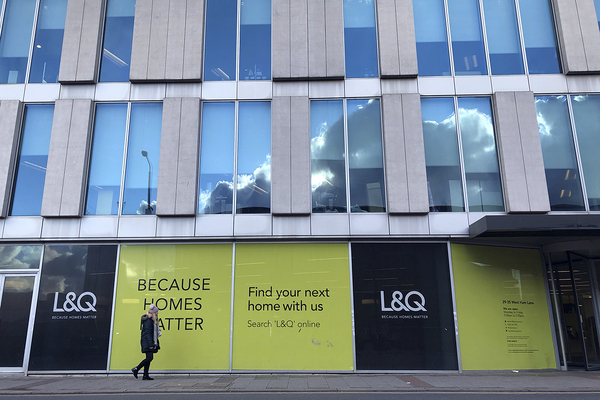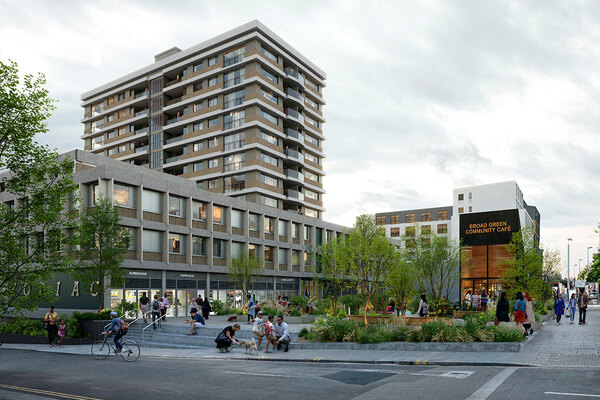You are viewing 1 of your 1 free articles
Grenfell Inquiry day 31: firefighter describes ‘incredibly difficult’ task of recording information
A firefighter involved in recording and collating information to help with the effort to rescue people trapped in Grenfell Tower on the night of the fire gave evidence to the public inquiry today.
Key points
- Firefighter Glynn Williams tells inquiry of the difficulties of recording where people were trapped in Grenfell Tower on the night of the fire
- He repeated evidence from other firefighters that he had never had training for a cladding fire or evacuation of a high-rise block
- He describes how it became difficult to get information from shocked and confused residents or firefighters
Firefighters have previously told the inquiry about their lack of training for the specific circumstances of the Grenfell Tower fire.
This continued today, with experienced firefighter Glynn Williams revealing that his training had never included cladding fires or the full or partial evacuation of a high-rise residential block.
Mr Williams said: “We do not receive training on how to evacuate people through a toxic environment.”
He added: “If you’re at an incident and fire survival guidance [FSG] is implemented, we don’t do any training that would mean we would take a conscious and breathing casualty into a toxic environment.”
Firefighters, however, improvised on the night, using training intended to rescue firefighters who become trapped to rescue Grenfell residents. In situations like this, firefighters take in spare breathing apparatus for their trapped colleagues to wear.
Mr Williams said he saw one firefighter leading a young girl out of the tower wearing spare breathing apparatus. He gave the girl his helmet to protect her from falling debris and burning plastic rain falling from the building.
On the night, it was Mr Williams’ job to stand at the bottom of the tower recording information coming in through FSG calls with residents.
With whiteboard space used up, he was writing on the wall of the tower in the lobby. He would write down a flat number to indicate that people needed rescuing, write ‘BA’ when firefighters with breathing apparatus had been sent there and tick the flat off when those firefighters returned.
He admitted that with the volume of information coming in, some of it was unreliable and therefore he could have been ticking off flats that firefighters hadn’t been to, which could have led to those flats being overlooked in subsequent rescue efforts.
He said: “It is a priority to rescue people who need rescuing, but we’re asking firefighters to ascend a tower to their potential death. It’s really important that we don’t do that needlessly.”
The inquiry heard that Mr Williams did not know how many floors were in the tower and did not have access to a floor plan of the building, while firefighters returning to the ground from higher levels repeatedly described the conditions as “confusing and disorientating”.
The bridgehead told him at one stage that firefighters would no longer “be committing above a certain floor”, he said, though he was unable to recall which storey became the cut-off.
He said that he was trying his “utmost” to collate and transfer details coming from FSG calls and survivors to the fire brigade’s bridgehead, but that “it was proving an incredibly difficult task” due to the volume of information he received.
The task of tracking where people were trapped within the tower was made harder by the fact that people were not always being rescued from where they had been recorded through an FSG call, he suggested, as firefighters encountered them while they tried to escape or take refuge in another flat.
Some FSG call information also appeared to miss him completely and go straight to the bridgehead, he said.
And he described how as the night wore on, he was able to obtain “less and less information” by speaking to rescued people and firefighters – which he took as a sign that conditions in the tower were “rapidly deteriorating”.
At one point, he requested a marker pen to write down the flat number where casualties had been found on their forehead or arm. However, many were not even certain where they had been when found by firefighters, he told the inquiry, and it became “nigh on impossible” to correlate information about the location of residents in the building.
The hearing continues.
The Grenfell Tower Inquiry
Closing statements
Day 85: victims' lawyers attack the fire brigade
Further expert evidence
Including some additional evidence from emergency call handlers, bereaved and relatives
Day 84: further evidence from survivors and relatives
Day 83: swift evacuation of tower possible if residents alerted
Day 82: initial fire was extinguished but then returned to the flat
Day 81: overheating fridge-freezer most likely cause of fire
Day 80: fire doors installed did not match product tested
Day 79: resident advised to stay put despite fire in flat
Day 78: insulation and cladding material below required standard
Day 77: molten plastic spread blaze down tower
Day 76: 'stay put' should be dropped when fire spreads across floors
Other witness evidence
Police, ambulance, gas suppliers, council, TMO and call room operators give evidence
Day 75: call room operators give evidence
Day 74: further evidence from TMO officers
Day 73: TMO boss failed to pass information to firefighters
Day 72: fire finally extinguished when gas switched off
Day 71: further questions over stay put advice
Day 70: the police evidence
The bereaved, survivors and relatives’ evidence
Day 69: video shows smoke billowing through fire door
Day 68: KCTMO removed self closing mechanism and never replaced it
Day 67: gaps in cladding fixed with duct tape
Day 66: 'don't fix broken system with a sticking plaster'
Day 65: survivor dragged disabled man down nine floors to safety
Day 64: KCTMO 'did not replace broken fire door'
Day 63: foam insulation inside cladding 'exposed' says survivor
Day 62: father gives harrowing account of son's death
Day 61: council’s management organisation slammed for faulty electrics
Day 60: stay put advice ‘led to deaths’, residents say
Day 59: residents describe problems with new windows
Day 58: survivor describes how daughter saved his life
Day 57: firefighter evidence ‘a slap in the face’, says survivor
Day 56: relations with contractor were ‘toxic’
Day 55: resident 'never happy' with stay-put advice
Day 54: tenant gives evidence about housing association
Day 53: stay put advice 'felt like trap'
Day 52: resident saved by son's phone call
The firefighters’ evidence
Day 51: firefighter feared encouraging residents to jump
Day 50: the LFB commissioner
Day 49: fire chief reveals frustration over lack of building plans
Day 48: internal fire spread 'bigger story' than cladding
Day 47: fire officer considered evacuating crews over building collapse fears
Day 46: 'we were improvising' senior firefighter admits
Day 45: firefighter urged for abandonment of 'stay put' policy
Day 44: firefighter recalls radio signal difficulties
Day 43: call hander 'uncomfortable' with insisting residents stay put
Day 42: residents only told to leave if they called fire brigade back
Day 41: breathing equipment delay 'hampered rescues on upper floors'
Day 40: chiefs told firefighters to abandon policy
Day 39: firefighters reveal dramatic rescue of children
Day 38: firefighters issue aplogies to families
Day 37: council 'unable to provide tower plans'
Day 36: QC defends inquiry process
Day 35: Javid would welcome interim recommendations
Day 34: water from hose 'too weak' to reach the flames
Day 33: 'oh my god, we've been telling people to stay put'
Day 32: further fire fighter describes lack of equipment and low water pressure
Day 31: 'incredibly difficult' task of recording information outlined
Day 30: struggle to maintain control over rescue operation described
Day 29: fire service 'overwhelmed' by survival guidance calls
Day 28: 'the building beat us'
Day 27: firefighters 'forced to abandon plans to reach roof'
Day 26: poor signage hindered rescue efforts
Day 25: water pressure left firefighting equipment 'like garden hose'
Day 24: decision to abandon 'stay put' explored
Day 23: TV images 'could have assissted' rescue effort
Day 22: description of hectic scenes in the control centre
Day 21: account from the fire service 'nerve centre'
Day 20: firefighter describes 'huge volume' of calls from trapped residents
Day 19: firefighter 'given no training on cladding fires'
Day 18: evacuation would have been 'huge catastrophe'
Day 17: firefighters describe access and lift issues
Day 16: scenes of carnage likened to 9/11
Day 15: firefighters recount trauma of survival guidance calls
Day 14: firefighters describe spread of blaze
Day 13: firefighters recall radio difficulties
Day 12: "it was like a war zone"
Day 11: questions raised over fire fighters' radios
Day 10: watch manager emotional under questioning
Day nine: lead firefighter 'not trained in stay put policy'
The expert reports: authors give evidence to inquiry
Day eight: where the fire started
Day seven: what was in the cladding?
Day six: the cause and spread of the fire
Day five: expert highlights key issues
Day four: firefighters defend response to fire
Day three: council and contractors appear for the first time
Day two: lawyers for the survivors make their case
Day one: expert evidence released on cladding and stay put
The commemoration hearings
30 May: Grenfell Council 'recognised it should not house disabled victim above four storeys'
29 May: Anger on day six of the Grenfell Inquiry
25 May: Grenfell families 'forced to live in chimney with stay put policy'
24 May: Grenfell family complained about father being housed on 17th floor
23 May: Tributes to children on third day of Grenfell hearings
22 May: Emotions run high as Grenfell bereaved shown footage of the tower burning
21 May: Grenfell victims share tributes as inquiry opens
